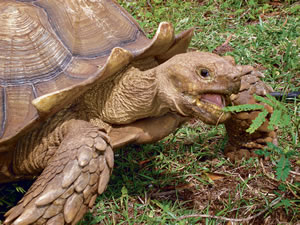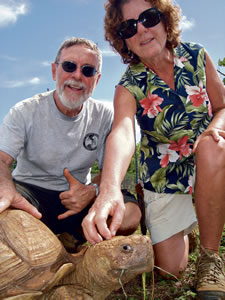Hungry Tortoises Come To The Rescue
To help preserve native plants, David and Lida Burney brought in three tortoises to help rid Makauwahi Cave Reserve of invasive weedsTortoises are helping native plants thrive at Makauwahi Cave Reserve.
Three African spurred tortoises are now serving as prehistoric grass-powered weed eaters, helping keep invasive species at bay. They were brought to the South Shore in July and are already making a significant impact on the six acres of land on which they reside.
The natural lawn mowers prefer grasses and low-lying vegetation like haole koa, says David Burney of Makauwahi Cave Reserve.
“We’re always trying to get rid of haole koa,” says Burney, as a 45-year-old tortoise named Chel, who loves to have his head scratched, munches on blades of guinea grass nearby.
The gentle giants are perfect for the job because most native plants are too high for the slow-moving creatures.
“They eat just the succulent stuff on the ground,” he says.
And they also don’t have teeth, which means they can’t eat the bark on native trees. In addition, there is no evidence of a tortoise ever becoming invasive, says David’s wife, Lida Pigott Burney.
The tortoises – which can live up to 100 years – are responsible for helping some 5,000 native plants that represent 40 different genres flourish.
Last year, approximately 5 million seeds were collected from the area they maintain. More than 4 million were sent to Lehua, an islet off Ni’ihau, as part of a restoration project, and many seeds were used for projects here.“It’s not as radical an idea as you think,” says Lida Burney regarding the tortoises.
Large, flightless ducks and geese, some as big as 60 pounds, used to roam the islands. The ancient birds, which became extinct soon after Polynesians arrived, were what Lida Burney calls, “grazers and browsers.”
“These guys fit the niche that those ducks and geese were in,” she says as she fondly points out each tortoise. “They do a really, really good job.”
Without the reptiles, the weeds would grow too rapidly and crowd out native plants. Using tortoises to assist native vegetation is an idea that has been executed before. The concept has already been introduced on the island of Rodrigues, located east of Mauritius in the Indian Ocean.
“The Indian Ocean is equivalent to Hawai’i,” says David Burney.
Giant tortoises were driven to extinction in all but one of the islands, and Charles Darwin thought to re-introduce them to the others.
“I was so impressed with that,” says David Burney regarding the project that excelled in bringing native plants back to life.
David Burney connected with University of Hawai’i professor, Dr. Jim Juvik, who helped establish the idea on Kaua’i.
Eventually, Lida Burney would like to have all 17 acres of the Grove Farm-owned land,where Makauwahi Cave Reserve is located, to house native plants.
The husband-wife duo, who started archeological research on Kaua’i in 1992, also hope to have a nursery as well.
Not only are the Burneys protecting native plants, they are helping the people of Hawai’i as well by hiring Ni’ihauans to work at Makauwahi Cave Reserve, which also contains an archaeological and paleontological site.
A grant recently approved by the Office of Hawaiian Affairs allows the Burneys to hire native Hawaiians from Ni’ihau to help with plant restoration.
“They’re a deprived community,” says Lida Burney, who, along with her husband, is originally from North Carolina. “It’s pretty much 100 percent unemployment on Ni’ihau, and they’re incredibly hard workers. I just like them so much.”
And the tortoises work well with the people in that they allow them to step off the constant tread-mill of pulling weeds.
“There are so many things that my crew can do besides weeding that is such a better use of their time and energy,” she says.





